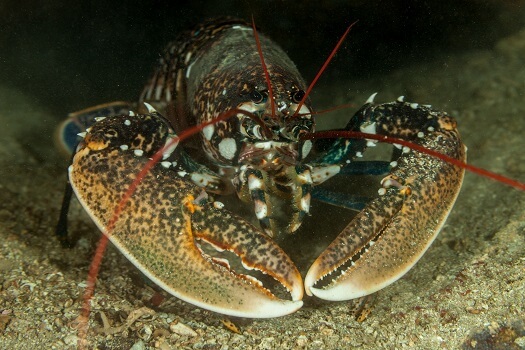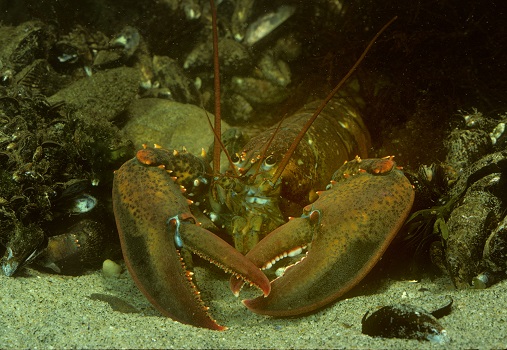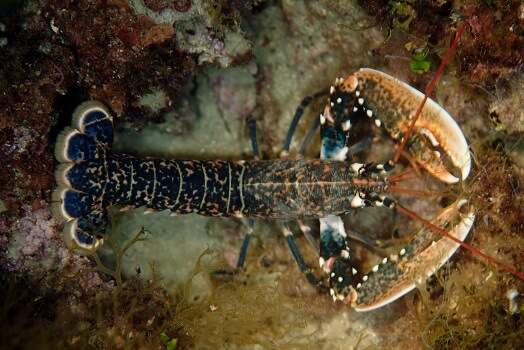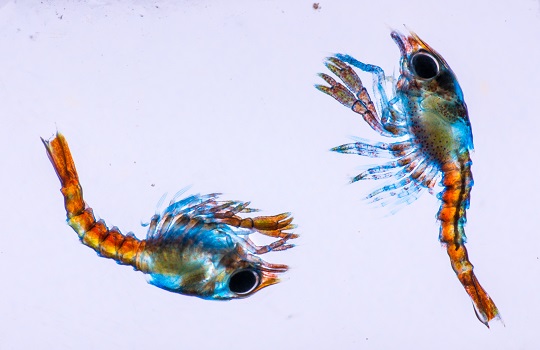
The lobster is a large, bottom-dwelling marine crustacean that belongs to the phylum Arthropoda. While many marine arthropods are referred to as lobsters by their common name, true lobsters belong to the family Neohropsidae, which is sometimes called Homaridae. The lobsters in this family have large pincers that are not found on marine crustaceans belonging to other families. Lobsters have a long, segmented exoskeleton that is made of chitin and a long, muscular tail. It has ten legs, with one or more pairs that are modified into pincers (chelae). The chela is usually larger on one side than the other. True lobsters have three pairs of pincers or chelae that are used for catching prey and for defense. The first pair of chelae are much larger than the others. Lobsters have long antennae and several swimming legs that are located on their abdomen. They also have compound eyes that are on moveable stalks. Lobsters are typically blue or green in color so that they blend in with the ocean floor. Interestingly, their blood is also blue due to the presence of hemocyanin, which contains copper. Lobsters have a fairly long lifespan, with scientists estimating that lobsters can live for as long as 40 to 50 years in the wild. Their age is estimated based on their size. Like most arthropods, lobsters continue to grow throughout their lift and go through molts. After each molt a lobster can add new muscle cells, enabling it to grow larger. Lobsters live in intertidal areas, hiding in crevices and caves. They are nocturnal and at night they can often be found crawling on the ocean floor seeking out a meal. They can crawl in all directions and back into their burrows. Lobsters eat a wide variety of prey including small fish, small mollusks, other bottom-dwelling invertebrates, and seaweed. These crustaceans are scavengers and so usually eat dead animals that are left behind but sometimes they will catch and eat live prey. Lobsters have several predators including crabs, eels, and seals. The main threats to lobster populations are overfishing and environmental change. Environmental change, like an increase in pollution, is causing an increase in shell rot and other diseases in animals that are usually fairly disease resistant. The northern or American lobster (Homarus americanus) is a large lobster found on the Atlantic coast of North America. It is distributed from Labrador to New Jersey. This lobster is the world’s heaviest crustacean, weighing in at over 44 lbs (20 kg). The European lobster (Homarus gammarus) is found in the eastern Atlantic Ocean, the Mediterranean Sea, and parts of the Black Sea. It is a species of clawed lobster and is closely related to the American lobster. The European lobster can reach up to 24 in (60 cm) long and weigh up to 13 lb (6 kg). These lobsters are blue in color, and only turn red when they have been cooked. Several populations of the European lobster are threatened by overfishing. The Norway lobster (Nephrops norvegicus), also known as the langoustine or scampi, is one of the most important commercial species. This lobster is orange-pink in color and can reach up to 10 in (25 cm) in length. It is the only extant species in the genus Nephrops. The Patagonian lobsterette (Thymops birsteini) is a lobster species found on the continental shelf around South America. It is found at depths of 390–4,920 ft (120–1,500 meters). Lobsters are quirky crustaceans that can grow indefinitely throughout their life and they have several weird and wonderful biological adaptations that make them suited to life in the ocean. From shedding their carapace to having teeth in their stomach, lobsters surely are fascinating creatures. Let’s take a closer look! One unique part of lobster reproduction is that a female must lose her carapace (hard outer-shell) before she can mate. When she is without her shell the female is at greater risk from predation so during this time a female will live inside a cave with the male who offers her protection. After they have mated the female stays with the male until her shell has regrown. This takes approximately two weeks and once complete the female can leave with the fertilized eggs. Once she leaves a new female will join the male. A male will mate with several females during the mating season. The female carries her eggs on the underside of her abdomen for approximately ten months. On average, a female will carry 8,000 eggs at a time but some female lobsters have been recorded as carrying as many as 100,000 eggs! Once the lobsters hatch, the larvae are released into the ocean waters where it floats at the surface for six to eight weeks feeding on plankton. The larvae will molt several times during this period, shedding its shell and replacing it with a new one. Once it has completed its fourth molt, the larva has grown large enough to descend to the ocean floor. It is estimated that only ten percent of lobster larvae make it to this stage. One cool adaptation that lobsters have is the ability to discard and regrow limbs! This ability to discard a limb is called autotomy or self-amputation and it is a self-defense mechanism that these lobsters use to escape from predators by either escaping their grasp or diverting their attention. This mechanism can be lifesaving! It’s not just their legs that lobsters can discard and regenerate – they can also regrow their claws and antennae! Several animals have the ability to discard body parts as a defense mechanism. Some lizards can shed their tails and the male octopus can detach one of its specialized reproduction arms during mating with a female. Autotomy is thought to have evolved nine times independently in the animal kingdom! While lots of animals can shed their limbs, not many can regrow them like the lobster can. A lobster’s teeth are located in its stomach! These teeth are part of a system called the gastric mill which crushes food so that it is ready for further digestion. Lobsters swallow their food whole and the three teeth in their stomach act like grinders, enabling the stomach to do the chewing. It is not only lobsters that use this method to break down their food – several other crustaceans also have teeth in their stomachs, with some such as the ghost crab, using the sound they make to ward off predators.
Kingdom
Animalia
Phylum
Arthropoda
Class
Malacostraca
Order
Decapoda
Family
Nephropsidae (coextensive with Homaridae)
Genus
Approximately 11
Species
Approximately 30
Niche
Carnivorous
Length
5.9in – 20in (15 – 50cm)
Weight
2.2 – 15lbs ( 1 – 7 kg)
Lifespan
20 – 80 years
Social Structure
Solitary
Status
Least Concern
Natural Habitat
Rocky and sandy ocean floor
Average Litter Size
12
Main food item
Clams, Mussels, Starfish, and Fish
Main threats
Overexploitation in some areas
The Basics


Fun Facts about the Lobster!
Females Shed Their Shell to Mate

Reflex Amputation
Gastric Mill
